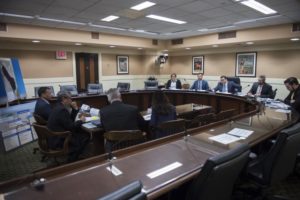
Assemblyman Eduardo Garcia (third from the left on the dais) questions a panel on the status of the Salton Sea Management Program (SSMP) during a State Legislative Water, Parks and Wildlife Committee hearing May 8 in Sacramento. Garcia, who represents the Imperial and Coachella valleys, raised concerns with the progress of the SSMP and sought information on what steps can be taken to meet restoration milestones at the Sea. Photo from the website of Assemblyman Garcia.
On Tuesday, May 8, the State’s restoration plan, the Salton Sea Management Program (SSMP), was the subject of a Sacramento hearing of the State’s Legislative Committee on Water, Parks and Wildlife, chaired by Assemblyman Eduardo Garcia, D-56th District, who represents the Imperial and Coachella valleys. Garcia and fellow committee members asked State agencies working on the Salton Sea what support they need from the Legislature to move the SSMP forward at a faster clip. The hearing comes amid concerns that the initial 2018 milestone for the SSMP set forth under a Stipulated Order (which established annual amounts of exposed acreage to be addressed through new habitat and air quality projects) will likely not be met by the year-end deadline. That time marker calls for the State to implement 500 acres of projects by December. The Stipulated Order also enables the State to make up for that missed milestone in 2019.
During the hearing, representatives from California’s Natural Resources Agency, Department of Fish and Wildlife, and Department of Water Resources outlined the status of the SSMP’s phase one ten-year plan, acknowledging that while it will be difficult to meet milestones by year end, they remain confident that construction on key projects will be under way and goals will start to be met in 2019. They also acknowledged there have been delays working through certain issues, like land liability matters, but again voiced optimism they are on the cusp of finalizing agreements that would enable key projects to move forward. They further said that once they work past such delays, and resolve liability issues, the path ahead toward implementing multiple restoration projects will become easier. Toward meeting the 500 acre-goal for 2018, they outlined two specific projects—New River West, which is an extension of the already-proposed Species Conservation Habitat (SCH) Project, and a new project to be built near Alcott Road on land leased by a geothermal company—Controlled Thermal Resources. Both projects are now in development and will be achievable in 2019, they say.
These two projects are in addition to the other projects the State expects to initiate by the end of the year—a 640-acre section of the SCH and a 500-acre federal wetlands project at Red Hill Marina. Additionally, plans for a North Lake project in Riverside County are under development and a 60-acre wetlands project, technically the first state-funded restoration project, was completed on Torres Martinez Desert Cahuilla land on the north side of the Sea.
One key success, State agencies pointed out, was legislation that has enabled them to move forward with projects at the Sea under design/build contracts, a project delivery method they expect will help to expedite projects. Additionally, State officials said as they work through phase one of the SSMP, they are also looking at long-term restoration under the concept of maintaining a smaller but sustainable Sea. Still, they are continuing to assess options regarding water importation to the Sea.
Despite assurances projects will soon be moving forward, State legislative representatives and other stakeholders voiced concern about the ability of State agencies and departments working on the Sea to meet the goals. One key issue of concern was whether the State has enough dedicated staff to accomplish its annual restoration milestones, regardless of opportunities through potential bond funding to secure enough financial resources to fully implement all phase one ten-year projects. State agencies acknowledged additional staffing could make a difference, especially as projects move ahead and as they manage multiple projects simultaneously.
Another concern voiced was whether the State has dedicated enough time and resources to reach out to communities living along the Sea that are considered disadvantaged. Representatives from environmental justice organizations said while the State has conducted outreach meetings with the public, those meetings have been designed to discuss the State’s progress and plans rather than formally engage the public in the decision-making process.
In the end, Assemblyman Garcia said he wants to ensure the State gives the Salton Sea the same attention it has focused on the Oroville Dam emergency and ensure the necessary resources are available to move past delays. He pointed out that there is a new focus by some to ensure the upcoming governor’s administration gives the Sea proper attention. While Garcia agrees with that, he added there still is time to get projects moving forward under the current administration, and that’s where the focus has to be now.
Another hearing on the status of the SSMP is expected to be held during the summer at a location along the Sea.
